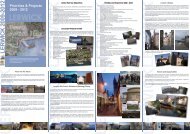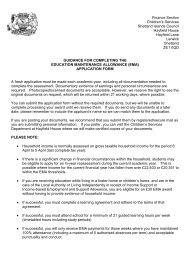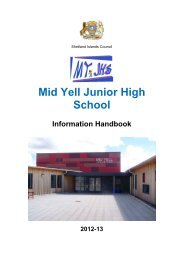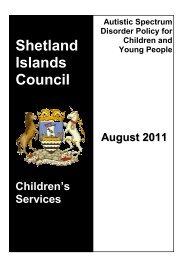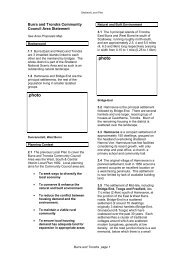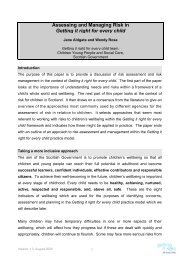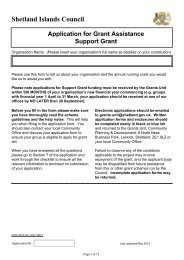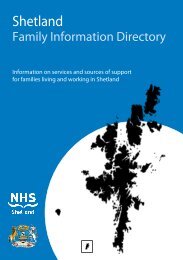Shetland Local Landscape Designation Review: Final Report
Shetland Local Landscape Designation Review: Final Report
Shetland Local Landscape Designation Review: Final Report
Create successful ePaper yourself
Turn your PDF publications into a flip-book with our unique Google optimized e-Paper software.
anked low or medium. Most other areas were ranked high, with more<br />
remote, undisturbed areas ranked very high.<br />
Scenic qualities<br />
7.6 Scenic quality across the islands is generally good, though the evaluation<br />
noted variations. The relative rankings shown in Figure 7.4 indicate that<br />
coastal areas were often rated highly. Areas ranked very high coincide with,<br />
but are not limited to, areas within the <strong>Shetland</strong> NSA. Much of Northmavine,<br />
West Mainland, and parts of the east coast were ranked very high, along with<br />
Fetlar and the Yell and Unst coasts. Inland areas, including the homogenous<br />
moorlands, were generally rated medium. The only two LCUs to be ranked<br />
low were the developed areas around Sullom Voe (LCU 15) and Lerwick<br />
(LCU 45).<br />
Enjoyment<br />
7.7 Enjoyment of the landscape in <strong>Shetland</strong> is predominantly informal, with<br />
coastal walks being the most popular means of access, especially in areas of<br />
scenic quality or where specific historic sites are present. The map of<br />
enjoyment rankings (Figure 7.5) reflects this, indicating the reduced rankings<br />
assigned to inaccessible areas. Low rankings were assigned to moorland<br />
areas not used for walking, and to the areas around Sullom Voe (LCU 15 and<br />
14). Very high rankings were assigned to the most popular areas, including<br />
Noss (LCU 47), St Ninian’s Isle (LCU 51), Esha Ness (LCU 22) and Burra<br />
Firth (LCU 1).<br />
Cultural qualities<br />
7.8 There are a large number of sites of cultural heritage importance across<br />
<strong>Shetland</strong>. The nature of these largely prehistoric features often renders them<br />
all but invisible to the untrained eye. The evaluation focused on the visible<br />
cultural dimension of each LCU, and as such many areas were assigned<br />
medium or low rankings, as shown in Figure 7.6. Very high rankings were<br />
assigned to areas where substantial cultural heritage features contributed<br />
visibly by their presence or by association, such as Jarlshof (LCU 52),<br />
Staneydale (LCU 31) and Tingwall (LCU 41). High rankings were assigned<br />
where features of lesser stature indicated time-depth and long-established<br />
settlement.<br />
Naturalness<br />
7.9 Almost all areas scored highly for naturalness, as shown in Figure 7.7. Most<br />
areas of <strong>Shetland</strong> have a high degree of naturalness due to the sparseness of<br />
settlement and infrastructure. Only the most developed areas around Sullom<br />
Voe (LCU 15), Brae, Voe and Aith (LCU 25), and Lerwick (LCU 45, 46 and<br />
48) were ranked low or medium. Uninhabited or inaccessible areas, such as<br />
the north-west coast of Yell, or the moorlands of Northmavine, were ranked<br />
very high.<br />
<strong>Shetland</strong> Islands <strong>Local</strong> <strong>Landscape</strong> <strong>Designation</strong> <strong>Review</strong><br />
Land Use Consultants<br />
<strong>Final</strong> <strong>Report</strong> 29 October 2011



